|
|
|
|
|
|
|
|
Visit India |
|
|
|
|
|
|
|
|
|
International Kite Festival
|
|
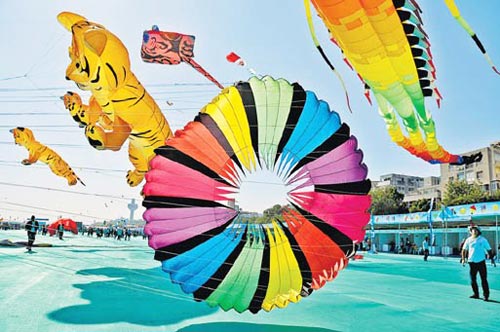 The International Kite Festival is celebrated on 14th January, that coincide with the festival of Uttarayan or Makar Sankranti. The festival is celebrated to mark the end of winter. On this day, the kites flew all over Gujarat, including Ahmedabad and Baroda. The people eat the special food on this day in the open field or in the park or in the garden of one’s home. This festival marks the movement of the sun into the northern hemisphere. The gods who are believed to have gone in a long sleep for six long months awake and the portals of heaven are thrown open.
The International Kite Festival is celebrated on 14th January, that coincide with the festival of Uttarayan or Makar Sankranti. The festival is celebrated to mark the end of winter. On this day, the kites flew all over Gujarat, including Ahmedabad and Baroda. The people eat the special food on this day in the open field or in the park or in the garden of one’s home. This festival marks the movement of the sun into the northern hemisphere. The gods who are believed to have gone in a long sleep for six long months awake and the portals of heaven are thrown open.
The visitors visit the temples and alms are distributed freely. The kite-
Kite Festival Gujarat
flying starts at dawn and continues without a pause throughout the day. Friends, neighbours and total strangers battle one another for supremacy and cries of triumph fill the air when they cut each other kites. The thread which is used to fly the kites are specially prepared by experts before the final day. Special mixtures of glue and ground glass cover the thread which is dried and then rolled onto reels known as firkees. In the night, various illuminated box kites, known as tukkals, fly in the sky. Today, the International Kite Festival is famous all over the world. This festival enables the people of Ahmedabad to see the unusual kites brought by the visitors, some of which are truly works of art.
|
|
| Modhera Dance Festival
|
|
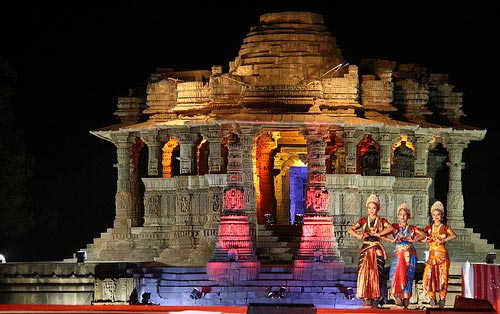 Psychedelic hues of red, yellow, green lights illuminating nooks and corners of intricately carved the Sun Temple of Modhera, during dark and breezy nights of January, create a Chiaroscuro effect of time and space! The Sun Temple of Modhera is a masterpiece of the Golden Age of the Solanki Empire, which hosts the annual Dance Festival and flaunts the glory and splendor of that era. Psychedelic hues of red, yellow, green lights illuminating nooks and corners of intricately carved the Sun Temple of Modhera, during dark and breezy nights of January, create a Chiaroscuro effect of time and space! The Sun Temple of Modhera is a masterpiece of the Golden Age of the Solanki Empire, which hosts the annual Dance Festival and flaunts the glory and splendor of that era.
The Modhera Dance Festival which is also prevalently known as the Uttarardh Mahotsavor Modhera Utsavis is one of the most famous celebration of art, music, dance and culture, in this part of the country. This unique occurrence showcases traditional dance forms of the region as well as acts as a platform bringing together the cultural ethos of other regions expressed in form of dance or nritya.
The three day festival of Uttarardh Mahotsavis is organized by the Tourism Corporation of Gujarat Limited (TCGL), to venerate and celebrate the inherited treasure of performing arts of the country. The Modhera festival is an ideal opportunity to experience living heritage of Indian dance and music while traversing back in time sitting in the lap of golden history.
|
|
| Bhavnath Fair |
|
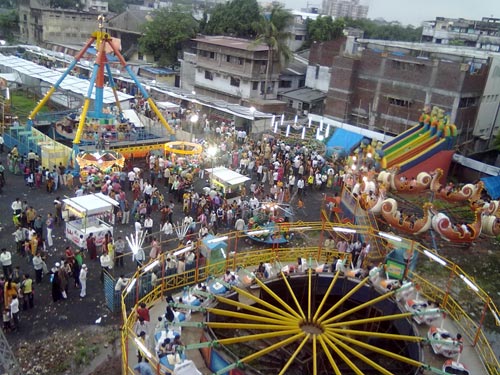 On the moonless night when it is believed Lord Shiva performed his tandava, the cosmic dance of destruction, a great mahapuja is performed. This great ritual begins at midnight on Mahashivaratri, when naga bavas, or naked sages, seated on elephants and decked in ornaments, arrive holding flags and blowing conch shells, tungis, and turis, the sounds of which reverberate through the entire space. Leading a large procession to the temple, they thus mark the commencement of an emotive religious ceremony. On the moonless night when it is believed Lord Shiva performed his tandava, the cosmic dance of destruction, a great mahapuja is performed. This great ritual begins at midnight on Mahashivaratri, when naga bavas, or naked sages, seated on elephants and decked in ornaments, arrive holding flags and blowing conch shells, tungis, and turis, the sounds of which reverberate through the entire space. Leading a large procession to the temple, they thus mark the commencement of an emotive religious ceremony.
Devotees believe that Shiva himself visits the shrine on this occasion. Girnar is said to be the abode of the nine immortal nathas, and eighty-four siddhas, all of whom also visit the temple in their invisible spirit forms during Mahashivaratri. Offerings are made to the deities, and the festive energy courses through performances of dance, music and traditional bhavai theatre.
|
|
| Navratri |
|
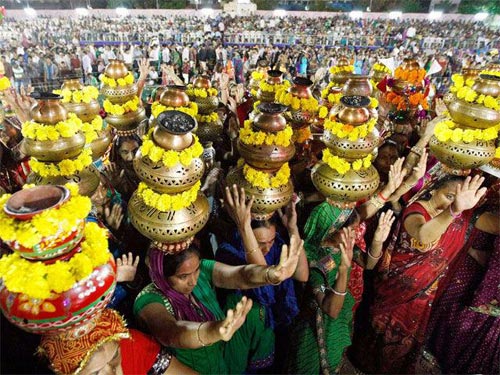 Navratri, meaning 'nine nights', is one of the most popular and widely celebrated Hindu festivals in many parts of India. Gujarat, however, is the only state that erupts into a nine-night dance festival, perhaps the longest in the world. Each night, all over the state, villages and cities alike, people gather in open spaces to celebrate feminine divinity, referred to as Shakti. Navratri, meaning 'nine nights', is one of the most popular and widely celebrated Hindu festivals in many parts of India. Gujarat, however, is the only state that erupts into a nine-night dance festival, perhaps the longest in the world. Each night, all over the state, villages and cities alike, people gather in open spaces to celebrate feminine divinity, referred to as Shakti.
The dance form known as ras garba (also joined sometimes by dandiya, which uses small wooden sticks), comes from Lord Krishna's worship rather than Goddess worship, from the Gop culture of Saurashtra and Kutch. Stories of relationships between Krishna and the Gopis, and their emotions, also often make their way into the ras garba music.
Nevertheless, the focal point of every garba circle is the small Goddess shrine erected by each community to mark the beginning of the festival, on the first day of the Hindu month of Ashwin. The shrine includes a garbo, an earthenware pot, in which a betel nut, coconut, and silver coin are placed.
|
|
|
Rann Utsav
|
|
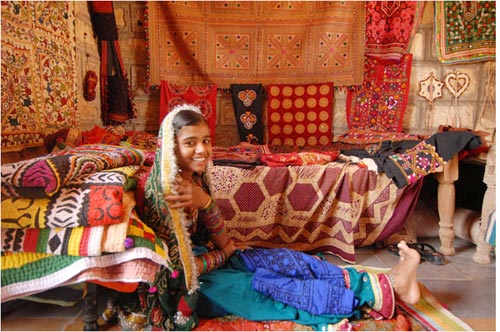 A plethora of varied hues, profusion of design, superfluity of culture, cornucopia of music and dance, all together in the arid lands of Kutch creates a mosaic of exquisiteness which reflects the identity and spirit of the region. Kutch, one of the most ecologically and ethnically diverse district of the state is a celebratory land of art, crafts, music, dance, people and nature.
A plethora of varied hues, profusion of design, superfluity of culture, cornucopia of music and dance, all together in the arid lands of Kutch creates a mosaic of exquisiteness which reflects the identity and spirit of the region. Kutch, one of the most ecologically and ethnically diverse district of the state is a celebratory land of art, crafts, music, dance, people and nature.
During the full moon night of the winters amid the awe-inspiring and contrasting landscape each year a three day festive extravaganza brimming with hospitality, vigor and traditional flavor of the area is hosted and known as the Kutch or Rann Mahotsav.
This month long carnival organized at the various locales within Kutch takes one around the natural grandiose while introducing the visitor to the indigenous cultural and ethnical flavor of the people. Semi parched Grasslands of the Banni hosts the most magnificent display of vernacular architecture as the exhibition platform for the varied range of arts and crafts of the region. While an array of folk music and dance performances organized in the shimmering moonlit landscape provides the most enchanting experience. The colorful fairs held near the beach or the banks of a lake swings one with the spirit of festivity, fervor and flamboyancy while the organized tour around Kutch is an ideal occasion to be part of the region and experience the zeal and uniqueness of the people through a celebration of life!
|
|
|
Bhadrapada Ambaji Fair |
|
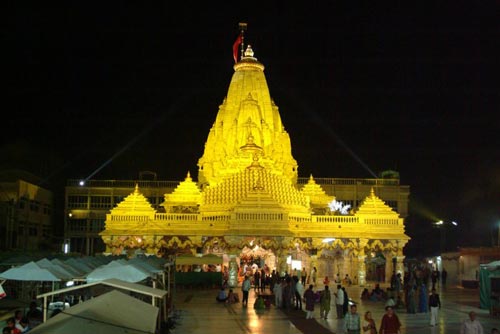 The Bhadrapad fair is held in the center of the Ambaji village just outside the temple premises. The village is visited by the largest number of sanghas [pilgrim groups] during the fair. Many of them go there on foot, which is particularly enriching as it happens immediately after the monsoon, when the landscape is rich with greenery, streams are full of sparkling water and the air is fresh. The Bhadrapad fair is held in the center of the Ambaji village just outside the temple premises. The village is visited by the largest number of sanghas [pilgrim groups] during the fair. Many of them go there on foot, which is particularly enriching as it happens immediately after the monsoon, when the landscape is rich with greenery, streams are full of sparkling water and the air is fresh.
During their stay at Ambaji, pilgrims spend their time in prayers and devotion and visiting other shrines nearby. Some of them also attend the readings of the Saptashati: 700 verses in praise of the Goddess Ambaji. In addition to the local shops, temporary stalls are erected selling eatables, toys, pictures and statues of idols, amulets, bamboo articles, etc. Merry-go-rounds and ferri wheels are set up for recreation, and acrobatics are performed.
On the night of the full moon, the sanghas also arrange performances of bhavai: a traditional and popular folk-drama, and garbas are sung in the chachar chowk, using simple musical instruments like pakhwaj, hungal and jhanjh.
|
|
|
Tarnetar Fair |
|
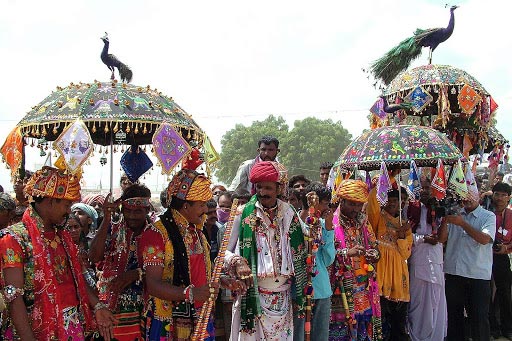 If you think you are prepared to walk out of your mundane experience and free-fall into a whirlwind of colors, romance and music, then head for the Tarnetar Fair.
Based on the legend of Draupadi's swayamvara, this fair is a celebration of ethnic Gujarat’s folk-dance, music, costumes and the arts, centered around young tribal men and women seeking marriage partners.
If you think you are prepared to walk out of your mundane experience and free-fall into a whirlwind of colors, romance and music, then head for the Tarnetar Fair.
Based on the legend of Draupadi's swayamvara, this fair is a celebration of ethnic Gujarat’s folk-dance, music, costumes and the arts, centered around young tribal men and women seeking marriage partners.
But even for those not interested in finding a spouse, the romance and excitement in the air are captivating, and every year the fair seems only to grow in popularity, attracting visitors and tourists from Gujarat, elsewhere in India, and even abroad.
Here the many colorful costumes, glittering ornaments and free-spirited movements of folk dances, all combine to create a memorable scene.
As the dancers surge in waves of circular movement, the incessant throbbing of the drums keeps them moving in unison, and the drum beats continue throughout the day even as the dancers change from one group to the next. Many kinds of folk dances are performed; by far the most popular is the raas, in which dancers hold sticks to clack against those of other dancers. As many as one to two hundred women perform rasadas in a single circle, to the beats of four drums at a time and the tunes of jodia pavas (double flutes). You may also see people break out into a spontaneous hudo. |
|
|
|
Scroll
|
|
|
|
 |
|
|
